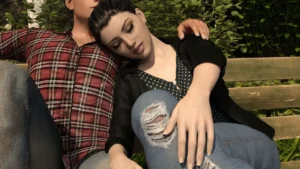
Sisterly Lust
Play Sisterly Lust
Sisterly Lust review
Master character relationships, corruption mechanics, and story paths in this adult visual novel
Sisterly Lust stands out as a sophisticated adult visual novel that goes beyond surface-level content to deliver meaningful storytelling and complex character development. Players take on the role of Max, returning home after years away to reconnect with family members. What makes this game compelling isn’t just the mature themes, but the intricate relationship systems, trust and corruption mechanics, and multiple branching storylines that reward careful decision-making. Whether you’re new to visual novels or a seasoned player, understanding the game’s core mechanics and character dynamics will significantly enhance your experience and help you unlock the full depth of what the game offers.
Understanding Core Mechanics: Trust, Corruption, and Character Progression
How Trust and Corruption Systems Shape Your Story
Let me tell you about my first disastrous playthrough of Sisterly Lust 😅. I thought I was being a charming, confident guy, making bold moves left and right. Next thing I knew, Rachel wouldn’t even speak to me, Bella slammed her bedroom door in my face, and my save file was essentially a digital ghost town. I had completely ignored the game’s delicate dual-stat system, and it cost me everything. Understanding this system isn’t just a suggestion—it’s the absolute key to unlocking the rich, branching narrative this visual novel offers.
At the heart of every interaction in Sisterly Lust are two pivotal stats: Trust and Corruption. Think of Trust as the foundation of your relationship house 🏠. If it’s strong, you can build something amazing on top of it. If it crumbles, the whole thing collapses. It’s the metric that determines whether the characters see you as a reliable, caring person. Let a character’s Trust fall too low, and their entire storyline can be permanently locked away. It’s that brutal, and that important.
On the other side of the coin is Corruption. This isn’t about being “evil”; it’s about a character’s willingness to explore their desires and break from their conventional mindset 🔓. While Trust opens the door to a relationship, Corruption is what determines how far that relationship can progress behind that door. A character with high Trust but low Corruption might see you as a wonderful friend and confidant, but they’ll shy away from more intimate scenarios. You need both stats working in tandem to see the full story.
The most crucial thing to remember is that these stats operate independently. An action that massively boosts Corruption might do very little for Trust, and vice-versa. This is the core of the Sisterly Lust trust system and the foundation of all visual novel relationship mechanics in this game. You’re not just building one “relationship meter”; you’re carefully managing two separate dials that influence different aspects of a character’s behavior and story availability.
Here’s a breakdown of how these stats typically function for the main characters:
| Character | Key Trust Threshold | Key Corruption Threshold | Unlocked Content Example |
|---|---|---|---|
| Rachel | Trust > 70 | Corruption > 50 | Access to more intimate, private conversations and scenarios. |
| Bella | Trust > 65 | Corruption > 60 | Willingness to engage in riskier, more exciting encounters. |
| Liza | Trust > 75 | Corruption > 55 | Opens up story paths involving deeper emotional and physical connection. |
| Rebeca | Trust > 80 | Corruption > 45 | Progresses the relationship beyond a superficial level. |
The beauty—and the challenge—of this system is that every choice has a cost and a benefit. This is where your Sisterly Lust stat management skills are tested. You can’t just spam “nice guy” options and expect to win. Sometimes, being a little bold or assertive (raising Corruption) is necessary to advance, but doing so at the wrong time can damage the Trust you’ve worked so hard to build. It’s a constant, engaging balancing act 🤹♂️.
Pro Tip: Save your game before every major decision! The consequences are permanent, and experimentation is the best way to learn the intricate Sisterly Lust trust system.
Character-Specific Mechanics and Relationship Paths
Okay, so you understand the basic stats. Now, let’s get personal. Each of the four main ladies—Rachel, Bella, Liza, and Rebeca—has her own personality, her own story, and most importantly, her own unique reaction to your stat-building efforts. A choice that sends Bella’s Corruption soaring might barely register with Rebeca. Treating them as interchangeable is a one-way ticket to failure.
Let’s use Liza as a detailed case study, as her early game is a perfect example of how one choice can define your entire character relationship paths.
Imagine this early scenario: Brody is hassling Liza. You have a few options:
* Punch Brody: This is the aggressive, protective choice.
* Verbally confront him: A more measured, diplomatic approach.
* Do nothing: The passive option.
I chose “punch Brody” on my first run, feeling like a hero. The immediate result? Liza got +1 Trust (she appreciates the help) but +2 Corruption (the violence and assertiveness excite her). This single choice nudged me onto a faster, more intense path with her. On a reload, I tried “do nothing.” The result was +3 Trust and +0 Corruption. She appreciated not causing a scene, strengthening our bond in a more gentle, traditional way. See how that works? 🤯 One decision, two radically different trajectories for the relationship.
This is the essence of the soft path vs hardcore path divergence. The “do nothing” choice is a classic soft path move. It builds a solid foundation of Trust slowly and safely. The “punch Brody” option is a hardcore path accelerator. It trades maximum Trust gains for a significant boost in Corruption, pushing the relationship into more daring territory much faster.
Now, let’s meet the rest of the family:
Rachel 🧑🦰: Rachel requires a great deal of patience and genuine care. Her Trust is hard to earn but easy to lose. She responds well to consistent, supportive choices. Pushing her Corruption too early is a surefire way to get shut down. You need to make her feel secure before she’ll ever consider exploring her wilder side.
Bella 😈: In many ways, Bella is the opposite of Rachel. She’s often more responsive to actions that increase her Corruption. She enjoys a bit of risk and excitement. However, neglecting her Trust will make her see you as just a thrill, locking you out of her more emotional and vulnerable moments. Balancing her stats is a delicate dance.
Rebeca 👩: As the mother figure, Rebeca’s thresholds are the most demanding. She has the highest Trust requirement, reflecting the significant societal and personal barriers in her path. Raising her Corruption requires subtlety and opportunities that often don’t appear until later in the game. Rushing her is the biggest mistake you can make.
Your Sisterly Lust stat management strategy must be tailored to each woman. There is no one-size-fits-all approach. What works for Bella will backfire spectacularly with Rachel. Pay close attention to their dialogue and reactions—they will tell you everything you need to know about where their stats currently stand.
Making Choices That Matter: Consequences and Outcomes
This is where everything comes together. In Sisterly Lust, there is no such thing as an “empty” choice. The game is constantly tracking your progress, and the consequences are both immediate and long-term. This section is your corruption mechanics guide to navigating those consequences and achieving the outcomes you desire.
The most direct consequence is content locking 🔒. I learned this the hard way. Let a character’s Trust dip below a critical threshold for too long, and a flag is triggered. Suddenly, options disappear from dialogues. Scenes that were available in a previous playthrough simply don’t occur. The character’s route is closed, often without any explicit warning. This is why knowing how to increase trust in Sisterly Lust is a fundamental survival skill. Consistent, caring choices are your insurance policy against this.
On the flip side, Corruption is your key 🔑. It literally unlocks specific scenes and scenarios that are otherwise inaccessible. A character with low Corruption will refuse certain advances, no matter how high their Trust is. They might trust you implicitly as a person but aren’t comfortable taking the relationship to that level. You need to carefully cultivate their willingness, which is what the corruption mechanics guide aspect of gameplay is all about.
So, how do you actually manage this? Here is some actionable advice for pursuing specific character relationship paths:
- Focus on One (or Two): On your first few playthroughs, don’t try to romance everyone simultaneously. The choices that please one character often upset another. Pick your favorite and focus your stat-building efforts on her.
- Read the Room: The game gives you hints! If a character blushes, becomes flustered, or seems intrigued by a bold suggestion, her Corruption is likely at a level where she’s receptive. If she becomes cold, changes the subject, or outright refuses, you’ve either overstepped a Trust or Corruption boundary.
- The Point of No Return: Be aware that major story decisions will often hard-lock you into a path. After a certain point, you cannot raise a neglected character’s stats high enough to pursue her route. Commit to your chosen path.
- Embrace Multiple Saves: This is the single most important piece of advice. Save often and in different slots. Label your saves based on major decisions (e.g., “Before Choosing Rachel/Bella”). This allows you to backtrack and explore different branches of the soft path vs hardcore path without replaying the entire game from the start.
Ultimately, mastering Sisterly Lust is about understanding that you are guiding a dynamic, living story. Your choices in dialogue, your actions in key events, and even the gifts you give all feed into this intricate web of stats and flags. There is no “perfect” playthrough, only the playthrough that you craft through your decisions. By respecting the Sisterly Lust trust system, strategically applying the principles of this corruption mechanics guide, and managing your stats with purpose, you can stop stumbling in the dark and start confidently bringing your deepest and most exciting story paths to life 🌟.
Sisterly Lust represents a thoughtful evolution in adult visual novel design, combining engaging storytelling with meaningful player agency through its trust and corruption systems. The game rewards careful decision-making and character understanding, offering multiple distinct paths through its narrative that feel genuinely different based on your choices. Whether you’re drawn to the complex relationship dynamics, the mature handling of unconventional themes, or simply the depth of character development, the game offers substantial content across multiple playthroughs. Understanding the core mechanics, character-specific requirements, and strategic decision points transforms the experience from casual entertainment into a genuinely engaging interactive narrative. Take time to explore different paths, pay attention to stat thresholds, and don’t hesitate to replay scenes with different approaches—the game’s design actively encourages this kind of experimentation and rewards players who engage deeply with its systems.



















